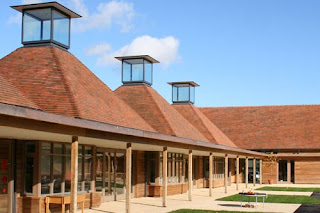Lanterns children's centre
This is very aggressive stuff and marks a distinct shift from the previous government’s position. So what has prompted such vitriol? Clearly it is perceived by the new government that architects are abusing the public purse for their own benefit. But there must be blame on both sides. Surely it should come as no surprise that if you ask an architect with a distinctive style to their work to design a building, then they will seek to provide a solution that builds upon their stylistic position. Also, if you do not want this to happen then it is probably a good idea not to select architects solely on the basis of an image of the proposed scheme but to look for a deeper understanding and response to the challenges of this fascinating but equally challenging building type.
 |
| Everest Community College |
If we consider post-war schools design then the work of Hampshire County Architects Department has been highly influential since the mid nineteen seventies. During this period they have completed many pioneering schemes for the authority as well as managing external practices to undertake both new build and refurbishment commissions. What is particularly interesting about this model is that their work has been underpinned by a continuous process of research that informs all projects. Under the leadership of Sir Colin Stansfield Smith the department has fostered strong links with academic instructions, including the Welsh School of Architecture, using this intelligence to directly inform the work that they produce and commission.
 |
| Osbourne School |
This approach allows them to be act as a truly “expert client”, defining a clear brief and then working with internal architectural teams or external practices to oversee it being successfully answered. Over the years they have worked with practices as diverse as Edward Cullinan Architects, Robert Adam and Michael Hopkins and Partners who have produced stylistically very different buildings but all underpinned by a clear understanding of what is needed to make successful school buildings. The focus across all projects is to achieve socially inclusive buildings that represent good value for money, minimise their environmental impact and costs in use while creating a well tempered environment for all users.
 |
| Pinewood Infant school |
While there are obvious benefits to the application of off-site construction, it is essential that the rich and complex nature of successful school building is not reduced to a simplistic and inappropriate caricature. Hampshire have spent considerable sums on trying to rehabilitate system schools of the 1960’s, many of which were already failing by the 1980’s. If prefabrication is to offer more than cost cutting but instead achieve real value, the answer is not to be prescriptive about layout but allow designers to respond to the physical and environmental contexts that each site presents. Modules could then be developed off-line by school specialists that would provide a highly engineered kit of parts that could then be arranged to make bespoke schools using common components.
If we are to avoid repeating the mistakes of the past it is essential that a third way is found where designers’ skills can be used to achieve social, economic and environmental benefits. As a profession, it is essential if we are to avoid being marginalised, that we are able to sell our skill, knowledge and expertise rather than simply selling a building style with a compelling image. If we do not, there is a real risk that all we will be left with is to be the stylist who designs the wrapper for standard solutions that have little or no relationship to the place or the environment in which they are located. Whatever the outcome one thing is for sure; if we as a society get it wrong it won’t be this government who will eventually pick up the bill.

